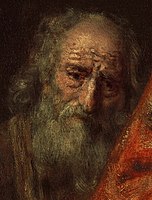David and Uriah
| David and Uriah | |
|---|---|
 | |
| Artist | Rembrandt van Rijn |
| Year | circa 1665 |
| Medium | oil on canvas |
| Dimensions | 127 cm × 116 cm (50 in × 46 in) |
| Location | Hermitage, St-Petersburg |
David and Uriah is a late painting by Rembrandt, dated to around 1665 by the Hermitage Museum (where it now hangs[1]) or c.1666-1669 in the 2015 Late Rembrandt exhibition at the Rijksmuseum. It shows the moment when David sends Uriah the Hittite to the front-line of the war with the Ammonites so that David can sleep with Uriah's wife Bathsheba.[2] Uriah is identified as the foreground figure, with David and Nathan in the background. It was first given this title by Abraham Bredius in his catalogue of Rembrandt's work - this has been supported by several other scholars from 1950 onwards, including in a 1965 study by Madlyn Kahr.[3]
The work has also been identified as Haman Recognises His Fate after Haman from the Book of Esther - it entered the Russian imperial collection in 1773 under that title and still hangs with that title in the Hermitage.[4][5]
Gallery[]

Nathan

Uriah

David
References[]
- ^ Catalogue page - Hermitage
- ^ (in Dutch) Melissa Ricketts: Rembrandt. Meester van licht en schaduw, Rebo, 2006, blz. 121. ISBN 9039619239
- ^ Web Gallery of Art entry
- ^ Madlyn Kahr: A Rembrandt Problem: Haman or Uriah? Journal of the Warburg and Courtauld Institutes. Vol. 28, 1965, blz. 258-273
- ^ Analyse in John Caroll: De teloorgang van de westerse cultuur. Een andere kijk op 500 jaar humanisme
- Paintings in the collection of the Hermitage Museum
- Paintings by Rembrandt
- 1660s paintings
- Paintings depicting David


